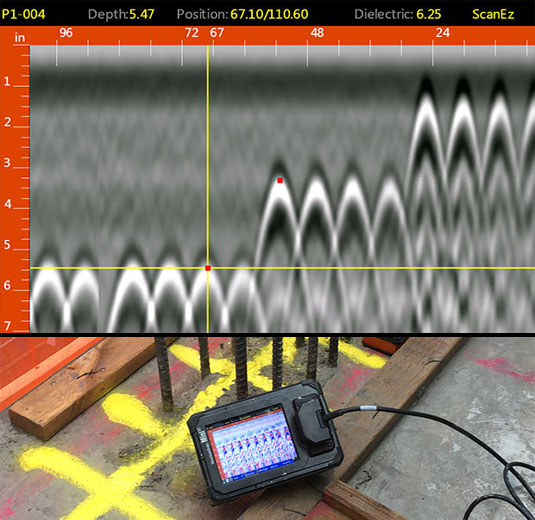Selecting the Right Concrete Scanning Devices
Selecting the Right Concrete Scanning Devices
Blog Article
Unveil the Transformative Power of Concrete Scanning in Maximizing Effectiveness and Safety And Security
Concrete scanning has actually arised as an essential tool in the building market, supplying unequaled advantages in boosting task performance and making certain safety standards. The transformative power of concrete scanning lies in its ability to offer real-time information and in-depth insights, revolutionizing how jobs are intended and carried out.
Value of Concrete Scanning
Ensuring the structural stability and safety of construction tasks begins with the crucial step of performing detailed concrete scanning. Concrete scanning is a non-destructive approach utilized to discover and map subsurface aspects within concrete frameworks. This procedure is important in determining prospective hazards, such as rebar, post-tension cords, and channels, that might be hidden within the concrete. By using advanced technologies like ground-penetrating radar (GPR) and electromagnetic induction, construction groups can precisely find these elements without causing any kind of damage to the structure.
The significance of concrete scanning can not be overstated, as it plays an important role in stopping crashes, lessening project hold-ups, and guaranteeing the lasting durability of the building. By identifying possible dangers prior to the building stage begins, contractors can execute ideal safety steps and make educated choices concerning the design and execution of the task. Furthermore, concrete scanning aids in maximizing job timelines and spending plan by preventing unexpected prices and delays that may occur because of unanticipated blockages within the concrete. Ultimately, investing in thorough concrete scanning is a proactive approach that enhances both efficiency and safety in construction tasks.
How Concrete Scanning Works
Concrete scanning operates as an essential tool in building and construction tasks by employing advanced innovations to discover and map subsurface aspects without causing structural damage. Ground Passing Through Radar (GPR) and Electromagnetic Induction (EMI) are 2 main techniques used in concrete scanning. GPR jobs by emitting high-frequency radar pulses into the surface, which recuperate when they encounter subsurface things or gaps. The time taken for the signal to return indicates the deepness and area of the objects. EMI, on the various other hand, makes use of electro-magnetic fields to identify differences in product make-ups, such as identifying rebar or avenues within concrete frameworks.
During the scanning process, the information gathered is assessed in real-time, enabling immediate identification of possible risks or barriers beneath the surface. This info aids in decision-making, ensuring that construction activities continue safely and effectively. In addition, 3D imaging software application can be used to produce detailed maps of the subsurface components, even more improving project planning and implementation. By utilizing these innovative innovations, concrete scanning considerably lowers the threat of pricey problems and injuries on building and construction websites.
Benefits of Concrete Scanning
One of the primary benefits of concrete scanning is the capability to find and locate embedded items such as rebar, post-tension cable televisions, and channels precisely. Concrete scanning assists in preparation and creating much more properly, as it provides precise details about the place and deepness of structural components.

Study: Concrete Scanning Success

In an additional situation, a building and construction company utilized 3D concrete scanning to assess the problem old concrete frameworks in a historic building. The thorough scans offered beneficial insights right into the degree of damage and aided focus on upkeep initiatives properly. By proactively addressing areas of worry determined through scanning, the company was able to expand the lifespan of the structure and ensure owner safety.
These instance researches emphasize the transformative power of concrete scanning in improving efficiency, precision, and safety and security in construction projects.
Applying Concrete Scanning in Projects
Implementing innovative scanning technologies during construction tasks has come to be significantly necessary for improving accuracy and safety and security. By integrating concrete scanning into job preparation and execution, building teams can identify find potential risks, such as rebar or post-tension cords, hidden within concrete frameworks. This aggressive strategy decreases the danger of crashes, delays, and costly rework, ultimately bring about much more effective task timelines and budgets.
To carry out concrete scanning effectively, task supervisors should work together carefully with skilled scanning professionals to establish one of the most appropriate scanning strategies for the specific job demands. Engaging scanning specialists from the beginning of a project makes it possible for the group to develop detailed scanning strategies that address key areas of concern and ensure complete information collection.
In addition, including concrete scanning right into routine task operations can simplify decision-making procedures, as real-time check data supplies immediate understandings right into the condition of concrete frameworks - Concrete Scanning. This data-driven technique helps with notified problem-solving and makes it possible for groups to make modifications immediately, promoting a society of effectiveness and safety and security throughout the task lifecycle

Conclusion
Finally, concrete scanning plays an important duty in improving performance and safety in construction tasks. By using advanced modern technology to map and find out underlying frameworks within concrete, this process aids to stop costly mistakes, make certain structural integrity, and decrease dangers on website. With the ability to reveal surprise components and supply precise information, concrete scanning shows to be a valuable device for enhancing task results and optimizing link total success.
Concrete scanning is a non-destructive find out here method utilized to detect and map subsurface elements within concrete structures. Furthermore, concrete scanning assists in enhancing task timelines and budget plan by preventing unanticipated expenses and hold-ups that may arise due to unpredicted blockages within the concrete. One remarkable case research includes a large-scale remodelling task where concrete scanning played a vital duty in ensuring project success.In one more situation, a construction firm used 3D concrete scanning to evaluate the condition of maturing concrete frameworks in a historic building. By integrating concrete scanning right into job planning and implementation, construction teams can recognize possible hazards, such as rebar or post-tension cords, concealed within concrete frameworks.
Report this page